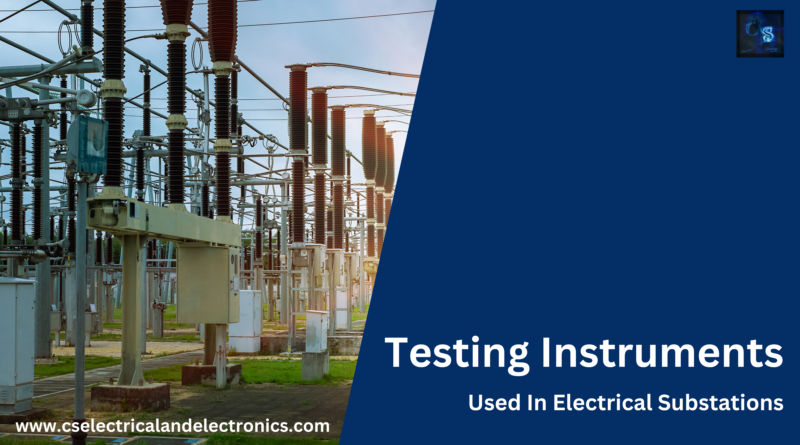Different Types Of Testing Instruments Used In Substations
Hello guys, welcome back to our blog. Here in this article, we will discuss the different types of testing instruments used in substations, what is the purpose of each testing instrument used in electrical substations, and their working.
If you have any electrical, electronics, and computer science doubts, then ask questions. You can also catch us on Instagram – CS Electrical & Electronics.
Also, read:
- World’s First Robot Lawyer In the US For Practicing Law, No License
- Top 100+ Python Projects With Source Code, Free For Students
- What Is Onboard Charger, Purpose, Onboard Charger Working
Testing Instruments Used In Substations
Introduction To Electrical Substation
An essential component of an electric power system used to transmit and distribute electricity is an electrical substation. It is a building that serves as a center for the transmission and delivery of electricity from a power plant to residences, commercial buildings, and other users.
A power plant’s high-voltage electricity is converted via an electrical substation into lower-voltage electricity that can be used locally. In the event of an outage or other issue, it also functions as a switching hub for power lines, allowing power to be diverted.
Transformers, switches, circuit breakers, and other pieces of equipment frequently make up electrical substations. These parts are used to regulate the flow of electricity, safeguard the power system from malfunctions and overloads, and make sure that power is delivered to customers in a reliable and effective manner.
Electrical substations come in a variety of shapes and sizes, including switching, distribution, and transmission substations. Although each type has a specific function in the power grid, they all play a vital part in ensuring that electricity is supplied to consumers consistently and safely.
Different Types Of Testing Instruments Used In Substations
There are various distinct types of testing instruments used in electrical substations to monitor, diagnose, and troubleshoot the equipment and systems. Among the testing equipment frequently used in substations are:
01. Multimeter:
An effective tool for measuring voltage, current, and resistance is a multimeter. It is a crucial instrument for electrical problem-solving and for evaluating the condition of different substation components.
02. Clamp Meter:
A clamp meter is a type of multimeter that is used to measure current without interrupting a circuit. Measuring the current flowing via high-voltage wires, it is especially helpful.
03. Insulation Resistance Tester:
Transformers, switchgear, and cables are just a few examples of electrical equipment whose insulation resistance is measured using an insulation resistance tester. It aids in the detection of insulation degradation over time.
04. Power Quality Analyzer:
The substation’s power supply quality is monitored using a power quality analyzer. It measures variables that can impact the functionality of tools and systems, including voltage fluctuations, harmonic distortion, and power factor.
05. Circuit Breaker Analyzer:
Circuit breakers’ timing, contact resistance, and insulation integrity are tested with a circuit breaker analyzer. It aids in ensuring that the circuit breakers can stop faults and safeguard the systems and equipment.
06. Partial Discharge Tester:
The partial discharges that take place in high-voltage equipment are found and measured using a partial discharge tester. Defects in insulation can be found earlier, preventing equipment failure or safety hazards.
07. Thermal Imaging Camera:
Electrical equipment temperature fluctuations are found using a thermal imaging camera. It can identify hot areas or overheating in the machinery, which could point to possible problems.
08. Ground Resistance Tester:
The resistance of the grounding system of a substation is measured using a ground resistance tester. It aids in ensuring that the grounding system effectively safeguards people and property from the risks of electrical shock.
09. Oscilloscope:
An oscilloscope is used to measure and analyze electrical signals, such as voltage and current waveforms. It aids in the diagnosis of electrical equipment and system issues such as harmonics, transients, and failures.
10. Frequency Response Analyzer:
The frequency response of electrical systems and equipment is measured using a frequency response analyzer. It aids in the diagnosis of resonance, stability, and control-related issues.
11. Transformer Oil Tester:
The performance and longevity of transformers depend on the quality of the transformer oil, which is tested using a transformer oil tester. It can identify impurities, deterioration, and moisture in the oil, all of which can impact the transformer’s insulating and cooling capabilities.
12. Relay Test Set:
To evaluate the effectiveness of protective relays, a relay test set is employed. To isolate the fault and safeguard the machinery and systems, it can simulate various fault scenarios and check that the relays work as intended.
13. Power Factor Test Set:
To determine the power factor of electrical components like capacitors and transformers, a power factor test kit is employed. It aids in ensuring that the machinery is running effectively and not using excessive energy.
14. High Voltage Test Set:
To assess the dielectric durability of electrical systems and equipment, a high-voltage test set is employed. It has the ability to stress equipment with high voltage while measuring leakage current and insulation resistance.
15. Dissolved Gas Analyzer:
Monitoring the gases dissolved in transformer oil involves using a dissolved gas analyzer. It has the ability to identify the presence of specific gases, including carbon dioxide, methane, and ethylene, which could be an early sign of a transformer failure or defect.
16. Cable Fault Locator:
To find defects in underground cables, a cable fault locator is employed. It can locate the fault and lessen the amount of excavation required for repair.
17. Battery Tester:
The performance and general condition of the batteries used in the substation are checked using a battery tester. It can help identify batteries that need to be replaced by measuring variables including voltage, current, and capacity.
18. Phase Angle Meter:
The phase angle difference between two voltage signals is determined using a phase angle meter. It aids in the diagnosis of issues with equipment breakdown, load imbalances, and power factor issues.
19. Micro-ohmmeter:
Low-resistance conductors, like busbars and switchgear contacts, are measured with a micro-ohmmeter. It can identify and pinpoint issues caused by corroded contacts, slack connections, and weak contacts.
20. Circuit Tracer:
To find circuits and identify issues, a circuit tracer is used to follow a circuit’s course through the substation. In order to isolate an issue, it can also be utilized to locate the proper circuit breaker.
21. Sound Level Meter:
The noise level in the substation is measured using a sound level meter. This makes it easier to guarantee that noise levels are within reasonable bounds and that workers at the substation aren’t subjected to excessive noise levels.
Why Testing Is Important In Electrical Substations
Testing is crucial in electrical substations for several reasons:
- Safety: Testing ensures that the equipment and systems in the substation are operating safely and within their designed parameters. Faulty or malfunctioning equipment can cause accidents or lead to electrical fires, putting the safety of workers and the public at risk.
- Reliability: Testing helps to ensure that the equipment in the substation is reliable and functioning as intended. This reduces the risk of unexpected downtime or power outages caused by equipment failure.
- Maintenance: Testing can help to identify problems before they cause major damage or failure, allowing for timely repairs or maintenance to be performed. This can help to extend the lifespan of the equipment and reduce the cost of repairs.
- Compliance: Testing is often required by regulatory agencies and standards organizations to ensure that the substation is in compliance with safety and performance standards.
- Performance: Testing can help to verify that the substation is operating at peak performance, maximizing efficiency and minimizing energy waste. This can help to reduce energy costs and improve the overall performance of the electrical grid.
Overall, testing is essential for ensuring the safe, reliable, and efficient operation of electrical substations. By identifying and addressing issues early on, testing can help to prevent costly downtime, improve performance, and ensure the safety of workers and the public.
This was about “Testing Instruments Used In Substations“. I hope this article may help you all a lot. Thank you for reading.
Also, read:
- 10 Tips To Maintain Battery For Long Life, Battery Maintainance
- 10 Tips To Save Electricity Bills, Save Money By Saving Electricity
- 100 (AI) Artificial Intelligence Applications In The Automotive Industry
- 100 + Electrical Engineering Projects For Students, Engineers
- 1000+ Control System Quiz, Top MCQ On Control System
- 1000+ Electrical Machines Quiz, Top MCQs On Electrical Machines
- 1000+ MATLAB Simulink Projects For MTech, Engineering Students
- 50 Tips To Save Electricity At Home, Shop, Industry, Office
Author Profile
- Chetu
- Interest's ~ Engineering | Entrepreneurship | Politics | History | Travelling | Content Writing | Technology | Cooking
Latest entries
 All PostsApril 19, 2024What Is Vector CANoe Tool, Why It Is Used In The Automotive Industry
All PostsApril 19, 2024What Is Vector CANoe Tool, Why It Is Used In The Automotive Industry All PostsApril 13, 2024What Is TCM, Transmission Control Module, Working, Purpose,
All PostsApril 13, 2024What Is TCM, Transmission Control Module, Working, Purpose, All PostsApril 12, 2024Top 100 HiL hardware in loop Interview Questions With Answers For Engineers
All PostsApril 12, 2024Top 100 HiL hardware in loop Interview Questions With Answers For Engineers All PostsMarch 22, 2024Driver Monitoring Systems In Vehicles, Working, Driver Sleepy Alert
All PostsMarch 22, 2024Driver Monitoring Systems In Vehicles, Working, Driver Sleepy Alert








